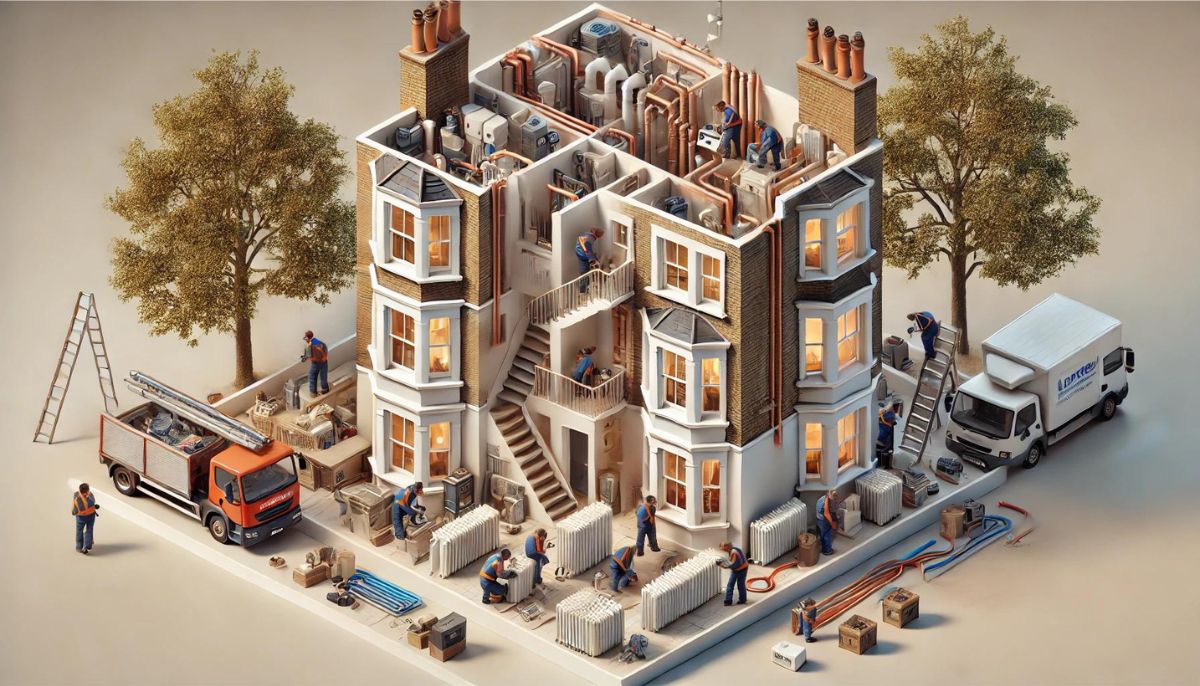In Britain, we have a dysfunctional relationship with the heat pump. They’re popular in the rest of Europe, and a proven way to electrify our heating. But still, people don’t trust them.
‘Heat pumps don’t work in British houses’, they say, ‘our homes are too old and drafty’.
And, I admit, we are world leaders in oldness and draftiness. But there’s another factor too. Heat pumps are just more complicated than boilers. A few bad installs (and it’s easy to do) have eroded the public trust.
So let me say it loud and clear: any house can have a heat pump.
Ok, that was a bold statement. The caveat is that some homes will incur more costs than others, in alterations, or in the efficiency of their system.
And you’ve probably read that sort of thing before. I have, and it’s frustratingly vague. I read things like ‘you’ll need new radiators’ and ‘the pipes aren’t wide enough’, but there’s not enough… maths.
So I did the reading, and I’m going to summarise the four main factors for you here. Considering there are some pretty hefty grants out there, it’s worth understanding the details.
Suitability Factor 1: Heat Loss of Property vs Heat Pump Power
Every home loses heat constantly. This heat is measured in Kilowatts (kW). Primarily it’s influenced by the type of insulation you have, and this is influenced by the age of the property.
Heat loss varies a lot. From 2.1kW for a modern flat, to 22.1kW for a pre-1900 detached house. But the average in the UK is about 7kW heat loss.

This (from BRE) is a set of estimates. In reality, every house will have a different number. This is calculated by your heating engineer, and is based on heat loss on the coldest day of the year (i.e. the date when a heat pump will be working its hardest).
You can get a rough idea of your heat loss using the Heat Engineer Loss Estimator.
So let’s say your heat loss is 7kW. Then you’ll need a heat pump which can output at least 7kW. But if your heat loss is at the really extreme end, over 20kW, then you’ll either need more power, or less heat loss.
Air Source Heat Pumps can go up to ~30kW, and Ground Source up to ~40kW. You can compare them all on the BRE website here. However, it may be more cost-effective to add some more insulation, and reduce the heat loss side of the calculation.
As you can see, this is already more complicated than a boiler. Combi boilers are rated over 20kW as standard, as they need to deliver instant heat. So they’re actually hugely overpowered for most UK properties, and this gives a wide margin for error.
Note: one alternative to getting a heat pump which covers your entire heat loss is to get a smaller heat pump PLUS some other heating system (e.g. boiler or infrared) for the coldest days. Remember, that 7kW heat loss will only be hit for a few days a year.
Suitability Factor 2: Radiator Size, and the Efficiency Problem
Here’s a pervasive myth: ‘with a heat pump you have to upgrade all your radiators’.
It’s usually not true. You may need to upgrade a couple, you may want to upgrade them all (I’ll explain why). But in any case, radiators are not crazy expensive (£100-£300 each), and they’re easy to change.
Why do you need new radiators with a heat pump? To understand that, we need to talk about flow temperature and efficiency.
(Now I’m going to declare immediately, if you want the really detailed version of this, have a look at the brilliant article by Zarch about his own heat pump installation. A lot of my information comes from this. But I’ll give you a slimmed-down version.)
Flow temperature is the temperature at which the water leaves your heat pump and travels round your heating system. You’ll be familiar with this from your boiler. It’s usually set to 70°C on a boiler, although can often be lowered. On a heat pump it ranges from 30°C to 70°C.
Efficiency is a measure of how much heating energy you get out per unit of electrical energy put in. A heat pump uses a compressor to amplify heat from outside into more heat inside. That compressor uses electricity. A heat pump is fantastically efficient, usually yielding over 3x energy in heat versus the electricity that is put in. Efficiency is measured in SCOP (Seasonal Coefficient of Performance) which is an annual average of efficiency, and is usually between 3 and 5 in heat pumps.
However, here comes the trade-off.
Flow temperature and efficiency have an inverse relationship. In other words, if you set your heat pump to flow hotter, your efficiency will go down. For instance, you could set the flow temperature at 55°C, but you might only see a SCOP of 3. Whereas if you keep it at 30°C, you might get a SCOP closer to 5.
Heat Pumps are much more efficient and cheaper to run at low temperatures. As I write this, the price of Electricity is 4.1x the price of Gas. Given a gas boiler has a SCOP of just under 1, you’d only save money over a gas boiler if your heat pump had a SCOP over 4, and you’d only get that at low flow temperatures
So what about radiators?
Ok, we now know that we want a low flow temperature. However, that creates another problem. Remember the heat loss from before? 7kW for our whole property? Well… it’s not that simple.
That 7kW is actually split out asymmetrically across all your rooms. You might have very little heat loss from an internal bathroom, or a room which adjoins your neighbour’s house, or one with no windows. But other rooms will be much leakier.
So the radiator problem comes in for those rooms where heat loss is greatest. If you turn your flow temperature down, the radiators in that room may not be able to cope. Radiators emit less heat at lower flow temperatures, which makes sense.
The answer? Get a radiator with a larger surface area.
You can increase the width or height, although that’s often not possible. So the answer is to increase the depth. Radiators come in different classes, from Type 11 (one panel and one ‘fin’) to Type 33 (three panels and three fins) and all the numbers in between. Screwfix has them listed with pictures here.
So will you need to upgrade your radiators? The most likely scenario is that you’ll want to upgrade a couple of them, most likely to Type 33 radiators, which will cost ~£500. And even this isn’t a requirement – it just makes financial sense for better efficiency.
Suitability Factor 3: Pipes – do they need upgrading?
Possibly. And this is less of a choice than radiators, to be honest. But don’t panic, it’s a common upgrade job, and you may only need upgrades to certain pipework (e.g. the main pipes from the heat pump itself).
Pipes need to be wide enough to transmit enough heat from the heat pump. Older properties will tend to have 15mm pipework, or less. Newer properties will be 22mm or more. Unfortunately those 15mm pipes usually can’t take enough power, as measured in kW.
| Pipe Gauge | Recommended Power Limit |
| 8mm | 0.75kW |
| 10mm | 1.15kW |
| 12mm | 1.72kW |
| 15mm | 2.75kW |
| 22mm | 6kW |
| 28mm | 10kW |
| 35mm | 15.75kW |
As you can see, to carry 6kW of power (which is what most homes will need) you’ll probably need 22mm pipes. 22mm is now the standard, but older homes might require an upgrade to certain parts of their system.
This, by the way, is very much the ‘abridged version’. I’ve simplified it to the most common use case – upgrading 15mm pipe to 22mm. However there is a lot of grey area here, and you can run a system slightly less efficiently, or increase the flow rate, both of which have negative consequences. The whole story (and these original figures) are on the Heat Geek website.
Suitability Factor 4: The Hot water cylinder
Unlike a combi boiler, heat pumps do need a hot water cylinder. Just as we’d all finished ripping them out, they have to go back in again!
According to the MCS, you want to size your cylinder to be at least 45 litres per occupant. It can be a bit less if you have a very powerful heat pump, and should be a bit more if you have unusually high demand (i.e. lots of baths).
Putting in a hot water cylinder will certainly cause issues in some houses. Although it seems like the least important factor, it could be the deal-breaker if you don’t have the space to spare.



